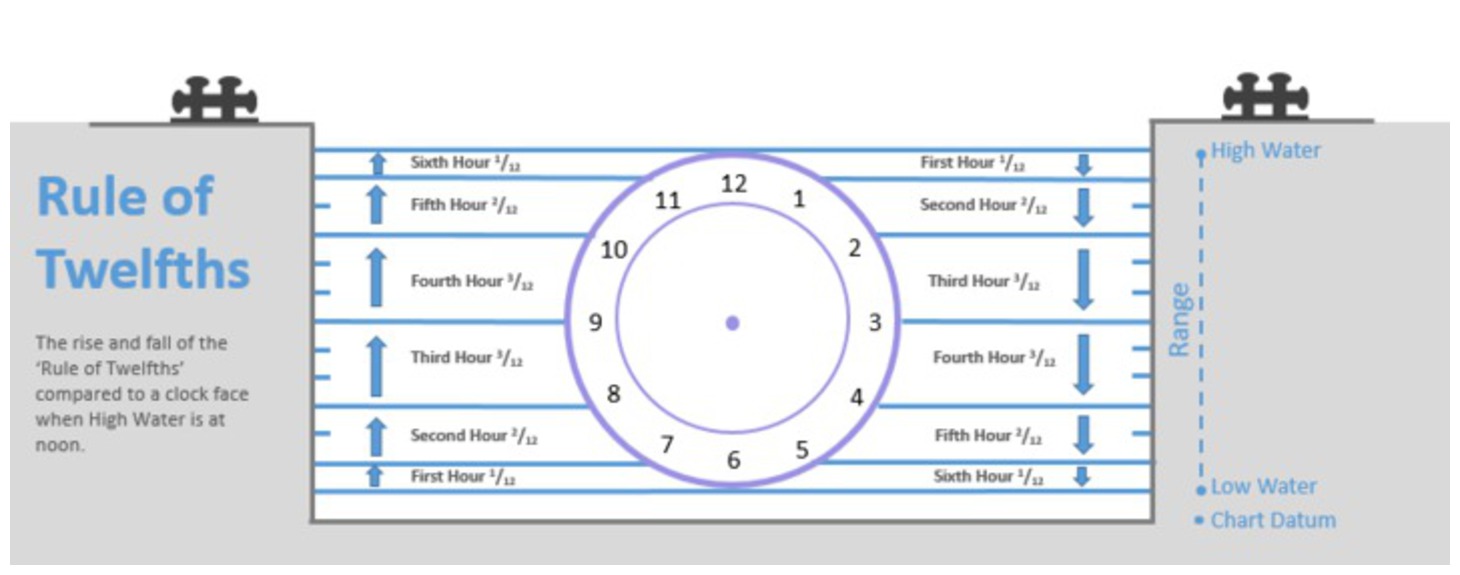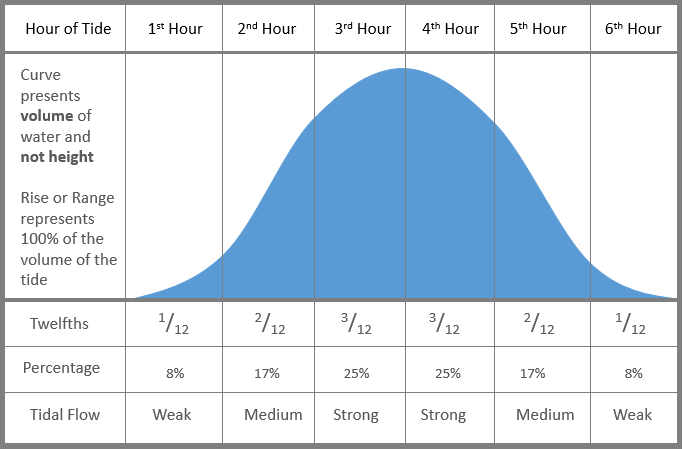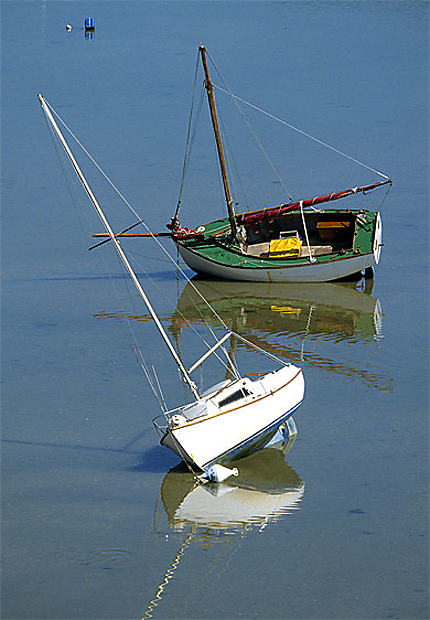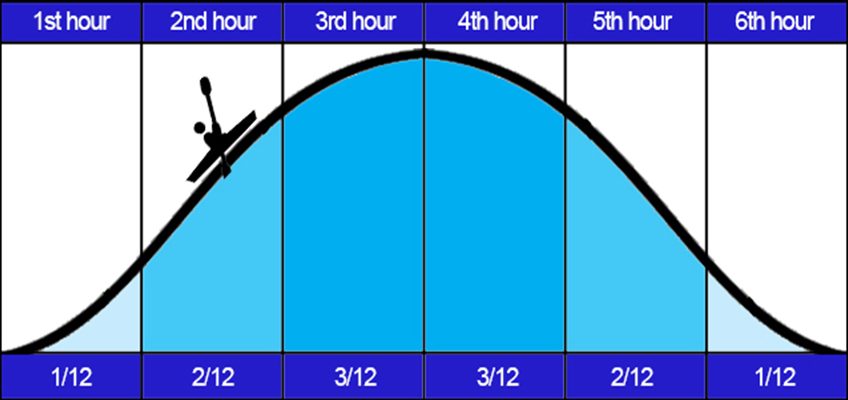Understanding tide dynamics involves recognizing how the Rule of Twelfths influences tide cycles which can be applied to very many aspects from fishing to boating. What is the Rule of Twelfths?
The Rule of Twelfths estimates tidal changes in 6-hour periods, assuming a linear rise and fall. It allocates 1/12th of the total tidal range for the first and sixth hours, and 3/12th for the third and ninth hours, providing a simplified prediction method for tidal heights and currents.
Mariners utilizing the rule of twelfths can navigate with enhanced precision, timing their departures and arrivals to align with the tides and using the tide’s natural motion to their advantage.
Introduction:
The Rule of Twelfths is a concept pivotal to comprehending the ebb and flow of tides. This introductory exploration not only unravels the scientific principles behind tidal movements but also provides sailors, surfers, and coastal enthusiasts with practical insights integral to their marine adventures. Anchoring our understanding of the gravitational pull of celestial bodies, we take a look through the rule’s mathematical elegance, offering readers easy-to-digest knowledge that enriches their appreciation of the sea’s perpetual motion.
Rule of Twelfths for Predicting Tides
For mariners and those with a keen interest in coastal navigation, understanding the movements of the tide is essential. One handy rule of thumb for estimating tidal heights is the rule of twelfths. This principle is particularly beneficial when faced with the absence of a tide table or when a quick approximation is needed. It becomes a vital component of maritime expertise, ensuring a safe voyage, whether circumnavigating rocky headlands or anchoring in tranquil bays. By learning to divide the time between high and low tide into twelve equal parts, you can gain a reasonably accurate idea of the water level at any given time, a crucial skill for avoiding groundings and taking advantage of tidal currents.
The rule of twelfths is based on an observation that, over six hours, the water level will increase or decrease in a predictable pattern between one low tide and the following or preceding high tide. To use this rule, one must first refer to the tide tables to establish the times of the high tides and low tides. With this information, the time between the high tide and low tide is sectioned off into twelve equal parts, with each part representing a twelfth of the tidal range.
Over the first hour after low tide, the water level will rise by one-twelfth. In the second hour, two twelfths will be added, reflecting an acceleration in the tidal rate. The third and fourth hours see the largest increase, adding three twelfths each hour, signifying the peak flow of the tide. As the tide approaches the next high tide, the rate slows down, with the fifth hour adding two twelfths and the final hour before high tide sees an addition of the last one-twelfth of the range.
Mariners utilizing the rule of twelfths can navigate with enhanced precision, timing their departures and arrivals to align with the tides and using the tide’s natural motion to their advantage. By incorporating the rhythm of the tides into their planning, they can navigate coastal waters with confidence. It’s a skill that’s as ancient as seafaring itself, yet it remains a cornerstone of modern coastal navigation techniques.
While the rule is remarkably useful, it is important to note that it assumes a semi-diurnal tide pattern, which means an area experiences two high tides and two low tides each day. The rule may be less accurate in areas with daily tides—where only one high tide and one low tide occur each day—or in mixed tidal patterns. Furthermore, real-world conditions such as weather fronts, wind, and atmospheric pressure can also affect tidal heights and should be considered alongside the rule of twelfths.
In conclusion, the rule of twelfths stands out as an essential navigational aid, offering a simplified method for estimating tidal heights without complete reliance on tide tables. Whether you’re a seasoned sailor or an enthusiast of marine navigation, this rule helps harness the power of the tides, allowing safe and efficient passage through the ever-changing coastal environments. With an understanding of both the limitations and applications of the rule, one can master the ebb and flow of the seas.
Deciphering Tide Tables: A Guide to Anticipating Low Tide and High Tide
Deciphering tide tables is crucial for anticipating low-tide and high-tide events. These tables provide essential information on the timing and magnitude of tidal changes. High tide occurs when water levels reach their maximum, while low tide is when they decrease to the minimum.
Understanding these patterns is vital for various activities such as boating, fishing, and beachcombing. By consulting tide tables, individuals can plan their endeavors to align with favorable tidal conditions, enhancing safety and optimizing experiences in coastal environments.
A simplified ‘Rule of Twelfths’ method can be used to calculate intermediate times and heights between High and Low Water without having to refer to tidal curves or graphs. It’s a reasonably easy method that can produce results that prove acceptable for most sailors.

When setting out to sea, understanding how to read tide tables is crucial for the safety and efficiency of your voyage, whether you’re steering a small boat or commanding a larger vessel.
Tide tables chart the expected times and heights of high tides and low tides, providing invaluable information to sailors and marine enthusiasts alike.
The pattern of tides, governed by celestial influences, reveals that slack water occurs at or close to high and low tides, presenting a period of minimal current that is ideal for certain maritime activities.
By mastering the rule of twelfths, one can predict the water level at any given hour between tides, visualizing the tide as a curve that peaks at high tide and dips during low tide.
Mid tide, falling in the middle of the transition between high and low water levels, is a critical phase to understand; this is when the water moves most swiftly, implementing robust tidal streams. The rule of twelfths assists navigators in determining the expected water depth by breaking down the progression of the tide into six parts: two twelfths in the first hour, three in the second, three in the third, two in the fourth, and one in the last two hours.
Utilizing this curve, one can anticipate the changing conditions and plan the safest and most efficient route for their boats. Furthermore, by diligently reading the tide tables, mariners can identify both spring tide and neap tide phases, the former signifying larger tidal ranges due to the combined gravitational forces of the moon and sun, and the latter indicating smaller ranges when these celestial bodies are at right angles to each other.
For those who take to the sea, knowing how to read the tables is as fundamental as knowing how to navigate by the stars. It’s not just about understanding the data presented; it’s about interpreting the curve of the tide’s progression. Spring tides, occurring roughly twice a month, yield the strongest currents, whereas neap tides produce relatively weaker tidal streams. This differentiation is particularly significant when planning a trip, as it affects mooring, anchorage, and even encounters with marine life.
To successfully predict the tidal flow, one must not only read but comprehend the subtleties expressed within tide tables. Recognizing that slack water aligns closely with both high and low tide, savvy sailors time their departure and arrival to capitalize on these moments of calm.
Tides ebb and flow with relentless certainty, and a well-informed mariner uses this predictability to their advantage. Whether engaged in casual boating or professional marine activities, an accurate interpretation of tide tables supported by the rule of twelfths stands as an indispensable tool in mastering coastal navigation.
Applying the Rule of Twelfths to Optimize Surf Sessions
For avid surfers and coastal navigators, understanding and applying the rule of twelfths to tide prediction can elevate the surfing experience to soaring new heights. The rule of twelfths is a handy rule of thumb for estimating the rise and fall of tidal heights, breaking the cycle between high tide and low tide into a manageable prediction tool.
As the sea’s level is in continual flux, successfully dividing the time between high and low tide into twelve equal parts becomes crucial for those seeking the thrill of the surf. This method allows you to gauge not just the extent of the tide but also the speed at which the sea level changes, which in turn, can help anticipate the arrival of optimal surf conditions.
Applying the Rule of Twelfths to Optimize Surf Sessions:
- Understanding Tidal Phases: Recognize the six-hour tidal cycle and the linear rise and fall assumed by the Rule of Twelfths.
- Divide the Tide: Divide the tidal period into twelve equal parts or twelfths.
- First and Last Hour: Expect minimal tidal change during the first and last hours, allocating 1/12th of the total tidal range.
- Third and Ninth Hour: Anticipate the most rapid increase or decrease in tide during the third and ninth hours, representing 3/12ths of the total tidal range.
- Strategic Planning: Use the Rule of Twelfths for strategic planning of surf sessions, aiming to hit the waves during periods of increased tidal movement for optimal conditions.
Remember, while the Rule of Twelfths provides a quick estimate, local factors, and more detailed tidal predictions should also be considered for accurate planning.
 Each of these equal parts signifies approximately one hour, and it’s within this framework that the water level experiences differential increases and decreases, known as the tide’s rise and fall. During the first hour after low tide, minuscule progress is made as the sea rises by only one-twelfth.
Each of these equal parts signifies approximately one hour, and it’s within this framework that the water level experiences differential increases and decreases, known as the tide’s rise and fall. During the first hour after low tide, minuscule progress is made as the sea rises by only one-twelfth.
Progressing into the next two hours, the level burgeons, rising two twelfths each hour, reflecting a more noticeable swell. This is often when surfers may begin to feel the pull to paddle out as the waves start to show promise.
As mid-tide approaches, a significant three-twelfth rise occurs each hour, signifying the sea’s surge toward high tide and the period when surf sessions often reach their zenith.
Conversely, after high tide has been reached, the slow ebb begins, following a mirrored version of the rising tide.
Slack water occurs at or close to high and low tide, offering a brief respite where the water is relatively still, a time often used for rest or preparation on the surfboard. Recognizing these periods is quintessential for any surfer aiming to leverage the tides. The session’s quality can be greatly enhanced by aligning one’s schedule with these pivotal tidal moments.
The rule suggests that tide levels do not rise or fall linearly, but in a more sinusoidal pattern, which can catch many by surprise if they’re expecting a steady change in sea level. By employing the rule of twelfths, the mystery is unraveled, granting surfers the forecast they need to plot out their sessions. Free of charge and easily applied, this rule becomes an indispensable part of a surfer’s toolkit, transforming their understanding of the tide into practical, session-enhancing knowledge.
Whether it’s the rush of the high tide or the retreat to lower levels, the ocean’s rhythm dictates the heartbeat of a surf session. Harnessing the power of the tide, rather than being at its mercy, ensures a surfer’s time at sea is optimized for the best waves on offer. Utilizing tide tables in conjunction with the rule of twelfths, surfers can tackle each session with confidence, knowing they’ve tapped into a tried and true method for predicting the ebb and flow of our vast oceans.
Understanding Tide Dynamics: How Twelfths Influence Tide Cycles
Understanding tide dynamics involves recognizing how the Rule of Twelfths influences tide cycles. This rule simplifies the prediction of tidal changes over six hours, emphasizing linear progression. By dividing the tidal cycle into twelfths and allocating specific proportions for each hour, the Rule of Twelfths provides a quick but basic tool for anticipating the ebb and flow of tides and is especially useful for surfers and mariners in optimizing their activities.

When it comes to coastal navigation, understanding the ebb and flow of the tide is essential for safety and efficient passage planning. The tide is a complex system, influenced by both the moon and the sun, that dictates the level of the sea at any given time. Boaters, sailors, and marine enthusiasts often turn to the rule of twelfths to divide the time between high and low tide into twelve equal parts, providing a reliable method to predict water levels. This rule is particularly useful in areas where slack water occurs at or close to high and low tide, marking periods of minimal current.
With each passing hour after the tide changes, the water level adjusts, and by applying the rule of twelfths, one can calculate the approximate water depth at any point. During the first hour—the inception phase of this cycle—only one-twelfth of the tidal change occurs, presenting minimal difference in sea level.
As we approach mid-tide, the difference is more noticeable. By the fourth and fifth hour, each represented by three twelfths, the water rises or falls most rapidly, moving towards the full height or depth of the expected tide. Essential for sailing, this knowledge helps anticipate the change and add precision to navigating channels or docking.
For boat owners and those enjoying a sail on the open water, the rule of twelfths works in tandem with tide tables to forecast the best times for activities. A sailboat may require a specific water level to avoid groundings, and understanding mid-tide dynamics can be critical for a successful trip. Furthermore, for those looking to work the tides—be it for sailing, fishing, or commercial boating—anticipating the times of faster tidal currents could add to the efficiency and safety of maritime operations.
Surfers, too, apply the rule of twelfths to optimize their surf sessions, knowing when the tide is just right for the particular break they’re riding. As tide changes can affect wave formations, timing your session with a rising or falling tide can be the difference between a good day and a great one on the water. By anticipating when the water level will be ideal, surfers can ensure they’re in the right place at the right time.
It’s important to remember that while the rule of twelfths provides a general guide, local conditions, and geographical anomalies can alter how the tide behaves. This is where tide tips from experienced boaters and knowledge of specific coastal areas become invaluable. Whether you’re out for safety, sport, or just leisure sailing, incorporating the rule of twelfths in your planning can aid in a smoother and more enjoyable boating experience. So, the next time you set sail, ensure that the twelfth rule and your understanding of tide cycles are working in your favor—for your boat, your crew, and your peace of mind under the ever-changing influence of the moon on the water level around you.
Conclusion:
Grasping the rule of twelfths provides mariners and coastal enthusiasts alike with a trustworthy method to predict the ebb and flow of the tides. This simple yet effective rule divides the tide cycle into six segments, aiding in the estimation of the water level at any given time between high tide and low tide. Understanding tides through this mathematical framework not only enhances safety during coastal navigation but also enriches the maritime experience, offering insights into the intricate dance between the moon, the sun, and Earth’s oceans.

References:
EOceanic- ‘Rule of Twelfths’: a simple method for estimating intermediate tidal heights
FAQ’s
Q: What is the Rule of Twelfths in marine navigation?
A: The Rule of Twelfths is a principle used to estimate tidal heights by dividing the time between high and low tide into twelve equal parts, with each part representing an increment of the tidal range. The rule outlines how the water level rises or falls at varying rates over each hour, providing mariners with a simplified method for predicting water depth.
Q: How does the Rule of Twelfths help sailors and surfers?
A: The Rule of Twelfths helps sailors and surfers by allowing them to calculate the approximate water level at different times between high and low tide, without complete reliance on tide tables. This information is crucial for safe navigation, avoiding groundings, leveraging tidal currents, and aligning activities such as surfing with optimal water conditions.
Q: Is the Rule of Twelfths accurate in all tidal conditions?
A: No, the Rule of Twelfths assumes a semi-diurnal tide pattern with two high tides and two low tides each day. It may be less accurate in areas with diurnal tides (one high and one low tide per day) or mixed tidal patterns. Additionally, weather conditions and geographical anomalies can affect its accuracy.
Q: How do tidal patterns affect marine activities like sailing and surfing?
A: Tidal patterns significantly impact marine activities. Sailing requires knowledge of water depths to avoid groundings, and the timing of tides affects navigation efficiency. For surfing, tidal changes influence wave formations—knowing when to catch a rising or falling tide can improve surfing conditions.
Q: Why is it crucial to understand and apply the Rule of Twelfths?
A: Understanding and applying the Rule of Twelfths is crucial for predicting tide levels, which is essential for the safety and efficiency of maritime activities. This knowledge allows individuals to navigate safely along coasts, plan voyages, and enjoy marine leisure activities with an understanding of the tide’s impact on their environment.



